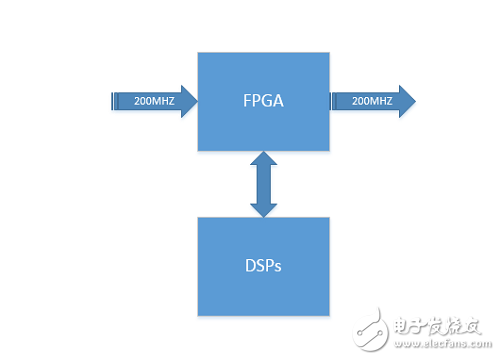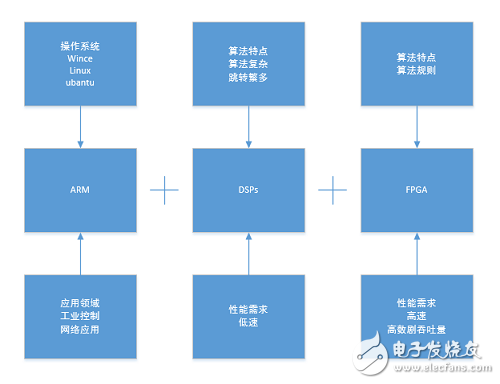Compare the advantages of FPGA, ARM, and DSP from the digital signal processing architecture, develop fixed-point Deep Recurrent neural networks using Theano, Python, PYNQ, and Zynq, and how to implement Linux UIO design on Zynq UltraScale+ MPSoC. Video image acquisition system based on Xilinx FPGA Programmable logic for data center interconnection Accelerate automotive electronics design with system optimization compiler How to write Verilog HDL efficiently - Advanced Edition FPGA-based HDMI high-definition display interface driver Accelerate automotive electronics design with system optimization compiler FPGA Simulation - Using Script Commands to Accelerate Simulation II Signal processing systems are generally not just analog signals or digital signals, and generally there are both. The processing of signals is concerned with the representation, transformation and operation of the signals and the information contained in the signals. Figure 1 Typical digital signal processing system 1) The input of an analog signal generally includes a continuous signal (sound, electricity, light, heat, etc.); 2) An analog signal anti-aliasing (anTI-aliasing filter) is intended to separate two or more aliased signals, or to enhance certain signals; 3" AD converts the analog signal into a digital signal; 4" DSP / FPGA / ARM / MPU digital signal processing. The entire system is divided into three domains, from analog to digital, to digital signal processing, to digital simulation. Digital signal processing generally involves sampling, filtering, transforming, detecting, spectral analysis, estimation, compression, and identification; the theory and algorithm of digital signal processing are inseparable; compared to analog signal system processing, digital signal processing volume Small, low power, high precision, easy to integrate on a large scale, and the advantages of two-dimensional and multi-dimensional processing. The performance of a digital signal processing system depends on three factors: sampling frequency, architecture, and word length. The DSP chip, also known as the digital signal processor, is a microprocessor that is particularly suitable for digital signal processing operations. Its main application is to implement various digital signal processing algorithms in real time and quickly. According to the requirements of digital signal processing, DSP chips generally have the following main features: (1) One multiplication and one addition can be completed in one instruction cycle; (2) The program and the data space are separated, and the instructions and data can be accessed simultaneously; (3) There is a fast RAM on the chip, which can usually be accessed simultaneously in two blocks through a separate data bus; (4) Hardware support with low overhead or no overhead loops and jumps; (5) Fast interrupt handling and hardware I/O support; (6) having a plurality of hardware address generators operating in a single cycle; (7) Multiple operations can be performed in parallel; (8) Support pipeline operations, so that operations such as fetching, decoding, and execution can be performed in an overlapping manner. Of course, other general-purpose functions of the DSP chip are relatively weak compared to general-purpose microprocessors. MPU (Microprocessor Unit) microprocessor The central processing unit (CPU) in a microcomputer is called a microprocessor (MPU) and is a core component of a microcomputer. It can also be said to be the heart of a microcomputer. It plays the role of controlling the operation of the entire microcomputer, generating control signals to control the corresponding components, and performing corresponding operations. The functional structure of the microprocessor mainly includes: the operator, the controller, and the register: The main function of the operator is to perform arithmetic operations and logic operations. The controller is the command center of the entire microcomputer system, and its main function is to control the execution of the program. This includes decoding, registering, and completing the specified operations, ie, instruction control, timing control, and operational control, as required by the instruction. Registers are used to store operands, intermediate data, and result data. FPGAs have a regularly programmable structure that implements a variety of logic functions. 1" has strong computing power and strong parallelism. 2" has great flexibility in the design process. 3" can reduce system cost through integration. Figure 2 FPGA as a coprocessing system Figure 3 FPGA as a preprocessing system Figure 4 FPGA + DSPs + ARM digital signal processing system As shown in Figures 2, 3 and 4 of the digital signal processing system, we can use different systems in different situations, depending on the respective advantages of the chip to select different systems. Molded Waterproofing Cable Assemblies We specialize in waterproofing products overmolding. We can custom build, custom mold, and over-mold your cable designs.
We specialize in molded cable manufacturing for the widest diversity of
cable and connector types, across the whole spectrum of industries. Rich expeirence in developing and proposing solution Special for IP67, IP68 waterproofing products. Molded waterproofing cable assemblies, waterproof wire harness, waterproofing cables overmolding ETOP WIREHARNESS LIMITED , https://www.oemmoldedcables.com


